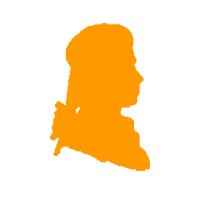Bach, Johann Sebastian - Prelude: "Christ lag in Todesbanden" for Flute & Guitar BWV 695 Flute and Guitar |
| Composer : | Bach, Johann Sebastian (1685 - 1750) | ||||
| Instrumentation : | Flute and Guitar | ||||
| Style : | Baroque | ||||
| Arranger : | MAGATAGAN, MICHAEL (1960 - ) | ||||
| Publisher : | MAGATAGAN, MICHAEL | ||||
| Copyright : | Public Domain | ||||
| Added by magataganm, 19 Sep 2016 Johann Sebastian Bach was a member of a family that had for generations been occupied in music. His sons were to continue the tradition, providing the foundation of a new style of music that prevailed in the later part of the eighteenth century. Johann Sebastian Bach himself represented the end of an age, the culmination of the Baroque in a magnificent synthesis of Italian melodic invention, French rhythmic dance forms and German contrapuntal mastery. Born in Eisenach in 1685, Bach was educated largely by his eldest brother, after the early death of his parents. At the age of eighteen he embarked on his career as a musician, serving first as a court musician at Weimar, before appointment as organist at Arnstadt. Four years later he moved to Mühlhausen as organist and the following year became organist and chamber musician to Duke Wilhelm Ernst of Weimar. Securing his release with difficulty, in 1717 he was appointed Kapellmeister to Prince Leopold of Anhalt-Cöthen and remained at Cöthen until 1723, when he moved to Leipzig as Cantor at the School of St.Thomas, with responsibility for the music of the five principal city churches. Bach was to remain in Leipzig until his death in 1750. As a craftsman obliged to fulfil the terms of his employment, Bach provided music suited to his various appointments. It was natural that his earlier work as an organist and something of an expert on the construction of organs, should result in music for that instrument. At Cöthen, where the Pietist leanings of the court made church music unnecessary, he provided a quantity of instrumental music for the court orchestra and its players. In Leipzig he began by composing series of cantatas for the church year, later turning his attention to instrumental music for the Collegium musicum of the University, and to the collection and ordering of his own compositions. The so-called Kirnberger Collection (BWV 690-713), a title now generally ignored in recent editions, is a collection of music by Bach copied by or for his pupil Johann Philipp Kirnberger. The latter was born in Saalfeld in 1721 and educated in Coburg and Cotha, before, in 1739, travelling to Leipzig for lessons in composition and performance with Bach. After a period spent in Poland, he returned to Dresden, moving then to Berlin as a violinist in the Prussian royal service. In 1754 he entered the service of Prince Heinrich of Prussia and four years later that of Princess Anna Amalia, remaining in this last position until his death in Berlin in 1783. Kirnberger had the highest regard for Bach, and did his utmost to bring about the posthumous publication of the latter's four-part chorale settings. "Christ lag in Todesbanden" (also "... in Todes Banden"; "Christ lay in death's bonds") is an Easter hymn by Martin Luther. Its melody is by Luther and Johann Walter. Both the text and the melody were based on earlier examples. It was published in 1524 in the Erfurt Enchiridion and in Walter's choral hymnal Eyn geystlich Gesangk Buchleyn. Various composers, including Pachelbel, Bach and Telemann, have used the hymn in their compositions. Some musicologists have dated this work to 1708, but its origins are difficult to pin down with complete accuracy. It likely comes from either Bach's years in Arnstadt (1703 -- 1707) or to that longer period in Weimar (1708 -- 1717). In any event, Christ lag in Todes Banden (Christ lay in the bonds of death) is a masterful fantasia, not to be confused with the earlier (?1703) Chorale Prelude BWV 718 of the same title. Both works depict Christ lying in the sepulcher with somber music that grows more animated in preparation for the grander mood that comes with the Resurrection. The Fantasia BWV 695 here opens in a mood of solemnity with grayish tones from in the lower register, the music, however, gradually growing restless and developing energy, the upper register carrying most of the main thematic material. As usual, Bach is to be admired for his brilliant contrapuntal writing throughout and deft ability to capture the mood of this great scene. There is no action to imagine as Christ lies in the tomb, but only the growing sense that some grand religious event will happen. As the music deftly builds, it takes on a more epic manner. Still, this D minor work, with a duration of about three minutes, remains relatively subdued in its ending compared with the grander BWV 718 version. Source: Naxos (http://www.naxos.com/mainsite/blurbs_reviews.asp?item_ code=8.553134&catN...). Although originally written for Pipe Organ, I created this Interpretation of the Chorale Prelude (BWV 695) "Christ lag in Todesbanden" (Christ lay in death's bonds) for Flute & Classical Guitar. Sheet central : | Chorals et préludes « Kirnberger » (56 sheet music) | | |||
By wrd2255, at 19:41
 | Nice! There's a lot of Bach out there for flute and guitar. Some good, some too simple or too complex. This is among the better arrs. I'e seen, and I've seen many. Always been a fan of the corresponding cantata. magataganm  , 15 Dec 2016 at 20:03 , 15 Dec 2016 at 20:03 ↪ Thank you! I'm glad you like it. I enjoy making these. |








